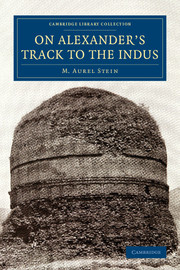
-
Select format
-
- Publisher:
- Cambridge University Press
- Publication date:
- June 2015
- November 2014
- ISBN:
- 9781139923538
- 9781108077606
- Dimensions:
- Weight & Pages:
- Dimensions:
- (229 x 152 mm)
- Weight & Pages:
- 0.47kg, 320 Pages
You may already have access via personal or institutional login
Book description
The Hungarian-born archaeologist Marc Aurel Stein (1862–1943) is probably best remembered today for his explorations in Chinese Turkestan, and especially his discovery of the Buddhist treasure of Dunhuang, described in his earlier works, Sand-Buried Ruins of Khotan and Ruins of Desert Cathay (also reissued in this series). Stein was equally interested in the territory north-west of the North-West Frontier, and in this highly illustrated 1929 work he describes an expedition to survey the route of Alexander the Great's invasion of India in 326 BCE. Having long been intrigued by 'that comparatively small area to the west of the Indus which Alexander's march of conquest towards India for a brief span of time illuminates as it were with the light of a meteor', and by archaeological remains showing a blend of Hellenistic and Buddhist art, Stein offers a fascinating account of an ancient clash of civilisations.
Contents
Metrics
Full text views
Full text views help Loading metrics...
Loading metrics...
* Views captured on Cambridge Core between #date#. This data will be updated every 24 hours.
Usage data cannot currently be displayed.
Accessibility standard: Unknown
Why this information is here
This section outlines the accessibility features of this content - including support for screen readers, full keyboard navigation and high-contrast display options. This may not be relevant for you.
Accessibility Information
Accessibility compliance for the PDF of this book is currently unknown and may be updated in the future.


